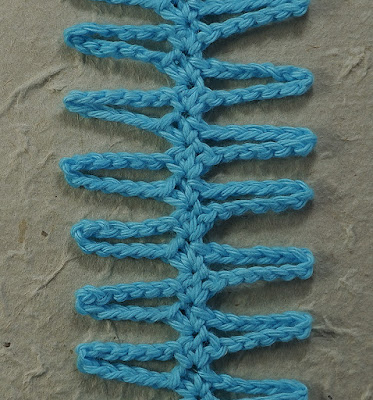When Mrs Micawber said; " I've wanted to experiment with Hairpin Lace using chained stitches instead of yarn loops", my response was "Uh?"
Let's face it, I am not an innovator. I am good at some things, like asking, "why?" and "what if?", I also have the patience to research and experiment. Sue Perez, aka Mrs Micawber, most certainly is an innovator. So after spending some time not being able to solve the problem, Sue, was kind enough to send me a simple set of instructions. Eureka! The 'what if?' side of my brain set fire to itself! The important thing to note is that, this is hairpin lace without a frame!
Here's what Sue told me... "chain three...
Repeat from *
I used 12 chains for the loop. Just as with Hairpin Lace the length of the loop depends on what you intend to do with the braid. But I'm getting ahead of myself!
The result feels a little dull so I start to think about ways to make it more interesting. [I aught to point out that I've made these examples in a relatively thick and unyieldy cotton yarn. Made in a lace weight or cotton thread the result would be quite different.]
I set up this sample with 3+12 chains and worked the 3Dc (SC-US). On the even numbered rows I worked Back-Loop Dc stitches and Front-Loops Dc on the odd rows.
This begins in the same way with 3+12 chain and 3Half-treble (Hdc-US). On the even rows I worked into the third loops and on the odd rows the Front-Loops.
It begins with 3+12 chains and 3Trebles (Dc-US). The even rows are Front-Post Trebles and the odd rows are Back-Post Trebles.
Making it this way it has a front and a back, which is which depends on what you are going for!
Alternatively I suppose you could make it with just Front Post stitches.Now it looks the same on both sides.
This was an accident, I was trying for crossed Trebles but it wasn't successful! This was my alternative, I suppose technically these are spike stitches. You'll need proper instructions for this.
Set up; 3+6 chains. Turn.
Row1; Skip the 6chain +another 2chain, 2Treble (Dc-US) in the last chain, Chain1, 2Treble in the first of the skipped 2chain and make around the first treble pair. 6chain. Turn.
Row2; Skip (6chain,2 treble,1chain) and make 2Treble in the next treble, Chain1, make 2Treble in the second of the skipped trebles. Chain6. Turn.
Repeat row2 to desired length.
This begins 1+6Chains, I skipped the 6chains and made a fan of (2Treble,1Chain,2Treble) in the last chain.
For each of the following rows I made the fan into the central chain1 of the previous fan.
Doesn't this look a lot like standard Hairpin lace? It begins 1+12Chains, followed by (1Double-crochet,1Chain,1Double-crochet) in the last chain. Just like before, this mini fan is made into the central chain1 of the previous row.
I began with 1+6Chain as before and made a 4Half-Treble Puff (Hdc-US) into the last chain. For each of the following rows I made the puff into the top of the previous one.
Mrs Micawber said; "Then join the strips as you would for regular Hairpin Crochet." Oh crikey!
Woven?I made this exactly as if it was standard hairpin lace. I wove the loops by pulling the left hand loop through the right hand loop, and the right through the left.
Zig-zag?
This is another common join, making a Double-crochet (Sc-US) into one loop followed by one or more chain stitches and a Dc into the opposing loop. The loops can be kept straight or twisted.Here I've gathered three loops together and added extra chains.
And double Zig-zag?In this example the first strip is edged and then the strips joined as the second strip is edged. I have also gathered the loops together, joining two loops with a single Double-crochet.
I can alter the shape of the chain loops by making more than one stitch in each loop.I made 3Double-crochet into each of these loops.
Because the loops are made of chain stitches I can choose to work into the actual chains rather than into the loops themselves.I've gathered three loops together by putting the hook through the back bump of a single chain from each of three loops and then made 3Double-crochet. This keeps the gathered stitches quite flat.
Our options are endless, there are so many more possible variations for stitches and joins. Different yarns will create different results and how shall we use the result? As a fabric, as a braid, as a section or border within standard crochet. I'm seeing sweater borders, an inset yoke, a throw, a mandala... so before my brain explodes I'm off for a lie down!
fastening off (and lying down)...
























No comments:
Post a Comment